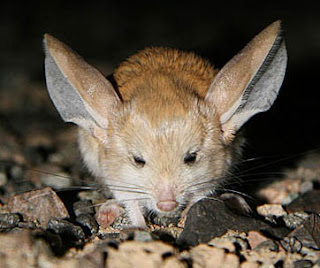A kangaroo mouse is either one of the two species of jumping mouse (genus Microdipodops) native to the deserts of the Southwestern United States, predominantly found in the state of Nevada. The name "kangaroo mouse" refers to the species' extraordinary jumping ability, as well as its habit of bipedal locomotion. The two species are:
• Pale Kangaroo Mouse - Microdipodops pallidus
• Dark Kangaroo Mouse - Microdipodops megacephalus
Both species of kangaroo mouse live in sandy desert ecosystems, and forage for seeds and vegetation amongst the scrub brush of their native habitat. The Dark Kangaroo Mouse is also known to feed occasionally on insects and carrion. Interestingly, the mouse never drinks water, instead deriving it metabolically from the foods it eats. The kangaroo mouse collects food and maintains large caches in their burrows, which are excavated to a length of between 3 and 8 feet (1 to 2.5 meters). The burrow, the entrance to which the mouse covers during daylight hours, is also used to raise litters of between 2 and 7 young. The Pale Kangaroo Mouse burrows only in fine sand, while the Dark Kangaroo Mouse prefers fine, gravelly soils but may also burrow in sand or sandy soil. Kangaroo mice are nocturnal, and are most active in the two hours following sunset. They are believed to hibernate during cold weather.
The kangaroo mice are closely related to the kangaroo rats, which belong to the same subfamily, Dipodomyinae.
• Pale Kangaroo Mouse - Microdipodops pallidus
• Dark Kangaroo Mouse - Microdipodops megacephalus
Both species of kangaroo mouse live in sandy desert ecosystems, and forage for seeds and vegetation amongst the scrub brush of their native habitat. The Dark Kangaroo Mouse is also known to feed occasionally on insects and carrion. Interestingly, the mouse never drinks water, instead deriving it metabolically from the foods it eats. The kangaroo mouse collects food and maintains large caches in their burrows, which are excavated to a length of between 3 and 8 feet (1 to 2.5 meters). The burrow, the entrance to which the mouse covers during daylight hours, is also used to raise litters of between 2 and 7 young. The Pale Kangaroo Mouse burrows only in fine sand, while the Dark Kangaroo Mouse prefers fine, gravelly soils but may also burrow in sand or sandy soil. Kangaroo mice are nocturnal, and are most active in the two hours following sunset. They are believed to hibernate during cold weather.
The kangaroo mice are closely related to the kangaroo rats, which belong to the same subfamily, Dipodomyinae.
Kangaroo mouse
Fossil range: Late Pleistocene - Recent
Scientific classification
Kingdom: Animalia
Phylum: Chordata
Class: Mammalia
Order: Rodentia
Family: Heteromyidae
Subfamily: Dipodomyinae
Genus : Microdipodops
Merriam, 1891
Species :
Microdipodops megacephalus Microdipodops palllidus
Fossil range: Late Pleistocene - Recent
Scientific classification
Kingdom: Animalia
Phylum: Chordata
Class: Mammalia
Order: Rodentia
Family: Heteromyidae
Subfamily: Dipodomyinae
Genus : Microdipodops
Merriam, 1891
Species :
Microdipodops megacephalus Microdipodops palllidus






1 comment:
The last picture is not a kangaroo mouse, the "big eared" kangaroo-like rodents don't exist anywhere in the American continent. Interesting info, btw.
Post a Comment